BEIRUT (AP) — A system of thousands of ridges and canals across a floodplain in southern Iraq has long been believed to be the remnant of a massive agricultural system built by slave labor.
Now an international team of archaeologists has found new evidence to support the theory.
The team undertook testing to determine the construction dates of some of the massive earthen structures and found that they spanned several centuries, beginning around the time of a famous slave rebellion in the 9th century A.D. The research findings were published Monday in the journal Antiquity.
The enslaved people from that era are known today as the “Zanj,” a medieval Arabic term for the East African Swahili coast, although there are different theories about where in Africa most of them actually came from.
They carried out a large-scale revolt in Iraq in 869 AD under the Abbasid state, known today as the “Zanj rebellion.” The rebellion lasted for more than a decade until the Abbasid state regained control of the region in 883 A.D.
Many descendants of those enslaved people now live in the southern port city of Basra in modern-day Iraq.
While they are part of the fabric of modern-day Iraq, “their history has not been actually written or documented very well in our history,” said Jaafar Jotheri, a professor of archaeology at the University of Al-Qadisiyah in Iraq, who was part of the research team. Researchers from Durham and Newcastle universities in the U.K., Radboud University in the Netherlands, and the University of Basra in Iraq also took part.
“So that’s why this (finding) is very important, and what is next actually is to protect at least some of these huge structures for future work. It is minority heritage,” he said.
The researchers first reviewed recent satellite imagery and older images from the 1960s showing the remains of more than 7,000 massive manmade ridges across the Shaṭṭ al-Arab floodplain.
The size and scale of the network indicate the “investment of human labour on a grand scale,” the report in Antiquity said. Sites were selected across the system to be analyzed with radiocarbon and optically stimulated luminescence dating.
All four of the ridge crests sampled date to the period between the late ninth to mid-13th century A.D., situating their construction during the period when slave labor was in use in the area — and providing evidence that the use of slave labor likely continued for several centuries after the famous rebellion.
Their findings demonstrate “that these features were in use for a substantially longer period than previously assumed and, as such, they represent an important piece of Iraqi landscape heritage,” the researchers wrote.
The finding comes at the time of a resurgence of archaeology in Iraq, a country often referred to as the “cradle of civilization,” but where archaeological exploration has been stunted by decades of conflict that halted excavations and led to the looting of tens of thousands of artifacts.
In recent years, the digs have returned and thousands of stolen artifacts have been repatriated.
Abby Sewell, The Associated Press




